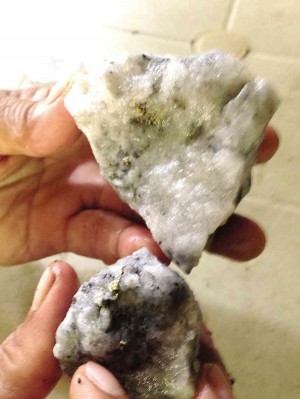
TRACES OF GOLD A villager shows gold particles embedded in rocks in Barangay (village) Dulangan, Magdiwang, Romblon. PHOTOS BY MARICAR CINCO
A recent spike in the mercury level, particularly in the gold-rich town on Sibuyan Island in Romblon, is one indicator that small-scale mining for the precious metal has resumed despite a total ban imposed by the provincial government.
Gov. Eduardo Firmalo believed that a number of villagers had returned to their old jobs during the May election period when the local government somewhat “loosened up” in the implementation of an ordinance declaring the mining moratorium.
“The mercury concentration in the air and waters in this municipality is presently at 800 micrograms/cubic meter,” Firmalo said in a phone interview on Monday. This was an increase from the desired level of 0-10 micrograms/cubic meter, but way far below the mercury level two years ago when it was at 30,000-50,000.
Miners use mercury in gold panning.
Defiant miners
In January 2011, when the provincial government imposed the mining ban, gold miners numbered around 2,000. Firmalo said the figure dropped to a handful of 30-40 after military forces began scouring the mountains for small-scale miners.
One miner, who was interviewed by the Inquirer last month, said the ban dealt a big blow to their livelihood, but a few of his associates went on.
“They are those who had to cling to knife’s edge to live,” Mayor Ibarra Manzala of Magdiwang, a fifth-class municipality (annual income: P15 million-P25 million), said in a phone interview.
It was not clear how mining began in Magdiwang, but Manzala, 69, said it could be during the American period.
Dionito Camal, the village chief of Dulangan where gold mining was most rampant, said the residents learned the practice from large companies that used to operate there. In fact, the village’s name was derived from dulang or the wooden pan used to extract minerals.
Over the years, the agricultural town (population: 13,584 as of 2010) remains poor.
Bonanza
“The few houses with iron roofs belong to those who earn from mining,” said the gold miner, who requested anonymity for security reasons. The rest are thatched huts.
Manzala said that before the ban, the villagers were able to send their children to college to become nurses and teachers on the island.
The miner said his eldest son became a policeman through his earnings from mining. “My problem now is my two other children in high school,” he said.
But, he said money from mining did not come easy, but at least the miners fared better than without any job at all, as not everyone owns a farm lot. He said he had been working in a construction site, but “that’s almost nothing as it is very rare that people here own concrete houses.”
Regulated
A team of 70 miners would spend about three months digging a pit at a depth of 20 feet to find gold. “We’re lucky to find gold, but sometimes we end up with nothing,” the miner said.
The current price of gold is P1,200 per gram, he said. Money from the sale of 100 grams of gold, for instance, is divided among them after 10 percent is deducted by “financiers” or middle men at the town proper.
The miner confirmed that mercury was being used to process the gold. “I’ve been doing this since I was 18. I’m now 43 and I don’t feel any effects of mercury,” he said.
ABANDONED Entrance to a 20-foot-deep mining tunnel that was abandoned several months ago in Barangay (village) Dulangan.
The provincial government had earlier issued a report about residents developing skin rashes, respiratory tract and intestinal diseases, and hypertension from decades of exposure to the toxic chemical.
This has also created a stigma about Dulangan. People from other towns warned the Inquirer against drinking tap water in the village as this may be laced with mercury.
“Let’s look at it with a greater flexibility. The gold deposits are there for a reason,” Manzala said. He said that if the municipality could find an alternative to mercury and allow small-scale operations but under a strict supervision, it could earn as much as P11 million a year just from the 12 percent government tax.
“That’s already 28 percent of our current P38 million IRA (internal revenue allotment),” he said.
Firmalo, however, has stood his ground about the mining ban. The provincial government, he said, would continue providing alternative livelihood, such as farming equipment and livestock, to discourage gold mining that also threatens to destroy the dense terrestrial reserve of Mt. Guiting-Guiting.
A court ruling in January nullified the indefinite mining ban. The provincial government, however, has appealed the decision.